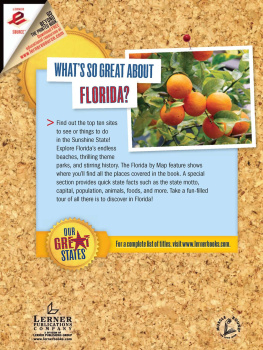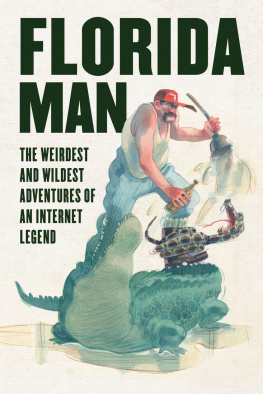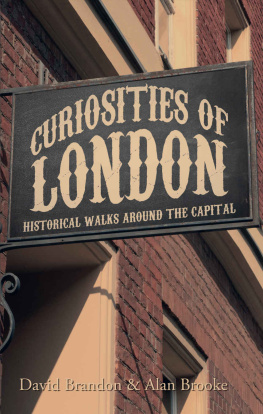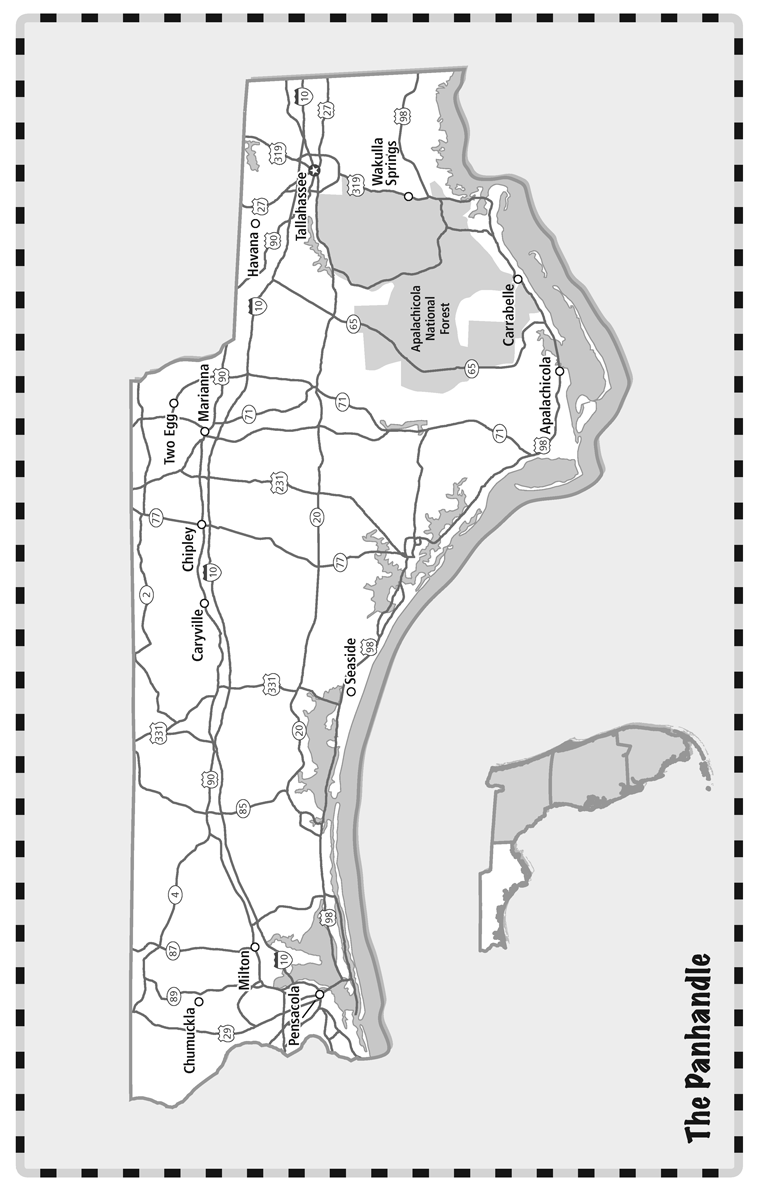about the authors
David Grimes is a humor writer based in Bradenton, Florida. He lives in a heavily mortgaged house that he shares with his wife, Teri, and two incontinent pugs.
Tom Becnel writes feature stories and an outdoor recreation column called Go! for the Sarasota Herald-Tribune. He lives in Port Charlotte with his wife, Naomi, and daughters Audrey and Mariethe Go! girls.
The Panhandle
The Panhandle isto Florida what Scotland is to Great Britain. In other words, an unwilling partner.
The northwesternmost arm of Florida tried to quit the mother state at least twice, the most embarrassing incident occurring shortly after the Civil War when the Panhandle tried to sell itself to Alabama for $1 million, only to have the offer turned down because the Alabama legislature considered that particular tract of Florida to be a sandbank and gopher region.
The Panhandle remains a part of Florida, but its heart and soul are way closer to Alabama and Georgia than they are to Miami, proving the old saw that the farther north you go in Florida, the more south you get. Sweet tea, grits and fried catfish continue to be staples in Panhandle cuisine, but the so-called Redneck Riviera has a lot more going for it than that. Apalachicola, on the Gulf Coast, is famous for its big, briny oysters. Nearby seaside towns entice tourists with fat, pink shrimp and succulent blue crabs. If you like seafood festivals, check out the Panhandle.
Perhaps because they consider themselves part of the Old South, Panhandle residents can be a bit contrary. Not only are most of the counties located in the Central rather than the Eastern Time Zone, the state capital, Tallahassee, is located in the Panhandle, apparently because its an inconvenient destination for just about everyone. People here also dont tend to get as worked up as folks to the south. Spring break moved from Ft. Lauderdale to Panama City years ago and the locals seem to deal with the annual uproar just fine. Its probably more stoicism than tolerance, brought on by hurricanes, oil spills and just about anything man and nature can throw at you.
The western part of the Panhandle is dominated by military installations, including Eglin Air Force Base and the Pensacola Naval Air Station. The aerial sky show known as the Blue Angels practices over Pensacola Beach. If youre in the area, its definitely a must-see. (Check times and locales at www.pensacolabeach.com/blue/.) The central part of the region is quickly becoming gentrified with the establishment of such planned communities as Seaside and Sandestin. Its a reminder that developers still rule Florida, even those parts that dont want to be a part of it. The eastern sectionand most of the Panhandle, for that matteris forest, with the exception of Tallahassee where the hot air has killed most of the trees. If you feel the need to cool off, a nice place to visit is Wakulla Springs, one of the largest and deepest freshwater springs in the world. While the 120-foot depths are murkier than they used to be, a dip in the 72-degree water is sure to clear your head, regardless of whether an alligator is eyeing you from the other shore. (For more information go to www.floridastateparks.org/wakullasprings.)
So the Panhandle is really a little piece of Florida away from Florida, a statement that probably doesnt make any sense unless youve been there.
The Ice Man Cometh Apalachicola
If you are able to live through a Florida summer without melting into a puddle of goo, you should give thanks to John Gorrie, the inventor of air-conditioning.
There may be some inventions we appreciate more than air-conditioningbeer springs immediately to mindbut they are hard to imagine when youve been working outdoors in August and take that first glorious step into an air-conditioned building.
John Gorrie did more for Florida tourism than Walt Disney.
How did people live in Florida before air-conditioning? Moistly is probably the best answer.
In 1842 Gorrie, an Apalachicola medical doctor, invented refrigeration as the result of experiments to lower patients fevers by cooling their hospital rooms. The scientific principleheating a gas by compressing it, cooling it by sending it through radiating coils, and then expanding the gas to cool it furtheris the same principle used in refrigerators and air conditioners today.
The story is that Gorrie was trying to build a machine to cool hospital rooms, but the thing kept freezing up and spewing out ice. Although Gorrie was granted the first U.S. patent for mechanical refrigeration in 1851, he never profited from it. Willis Haviland Carrier, who is often credited with inventing air-conditioning even though he only modified Gorries technology for commercial use sixty years later, made the money.
Gorries contribution to Southern living was so monumental that a museum was built in his honor in Apalachicola. Inside the one-room building is a model of his invention, which is really a primitive ice machine.
Gorrie, one of Apalachicolas pioneers, died there in 1855 at the age of fifty-one. A middle school in Jacksonville is named after him, and there is a statue of the inventor in the rotunda of the Capitol in Washington, D.C.
Pretty cool, huh?
The John Gorrie Museum is located at 46 Sixth Street in Apalachicola. The museum is open from 9:00 a.m. to 5:00 p.m. Thursday through Monday. A small admission is charged. Phone (850) 653-9347.
Shut Up and Shuck! Apalachicola
Believe it or not, Apalachicola, the Oyster Capital of the state, had until recently only one raw bar. Thats like Kansas City having only one steak house or Seattle only one Starbucks.
But its true. If you wanted to tuck in to some plump, salty, freshly shucked oysters tonged a few hours earlier from Apalachicola Bay, the only game in town was Boss Oyster.
A second raw bar, Papa Joes, opened a couple of years ago, but Boss Oyster is still viewed by many as The Place. They certainly shell out the shellfish, serving ninety-four tons in a typical year in a restaurant that seats 300, according to head chef Big Tim Strand.
While youre sitting on the open-air deck, trying to decide which one of the five varieties of hot sauce you want to sprinkle on your oysters, you can watch the shrimp and oyster boats pull into and out of the dock. Add a colorful sunset and you might think youve died and gone to seafood-lovers heaven.
Boss Oyster serves all kinds of seafoodcrab, shrimp, scallops, grouper, you name itbut the big attraction is the oysters. Presented on a bed of cracked ice, the enormous raw shellfish are sold by the dozen, though its the rare oyster lover who stops at twelve.
On our trip there, we got a bonus. Not only were the oysters wonderful, but we found three small pearls hiding in the shells. They werent entirely lucky, however. Our waitress still insisted we pay the bill.
Boss Oyster is located in the Apalachicola River Inn at 125 Water Street. Phone (850) 653-9364 or log on to www.apalachicolariverinn.com.
Talk Fast, Chief, Im Running out of Quarters Carrabelle
The middle of the Panhandle on the Gulf of Mexico is called the Forgotten Coast because it resembles (for now) what Florida looked like before Yankee transplants and condominiums ruined everything.









